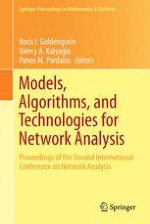This volume contains two types of papers—a selection of contributions from the “Second International Conference in Network Analysis” held in Nizhny Novgorod on May 7–9, 2012, and papers submitted to an "open call for papers" reflecting the activities of LATNA at the Higher School for Economics.
This volume contains many new results in modeling and powerful algorithmic solutions applied to problems in
• vehicle routing
• single machine scheduling
• modern financial markets
• cell formation in group technology
• brain activities of left- and right-handers
• speeding up algorithms for the maximum clique problem
• analysis and applications of different measures in clustering
The broad range of applications that can be described and analyzed by means of a network brings together researchers, practitioners, and other scientific communities from numerous fields such as Operations Research, Computer Science, Transportation, Energy, Social Sciences, and more. The contributions not only come from different fields, but also cover a broad range of topics relevant to the theory and practice of network analysis. Researchers, students, and engineers from various disciplines will benefit from the state-of-the-art in models, algorithms, technologies, and techniques presented.
